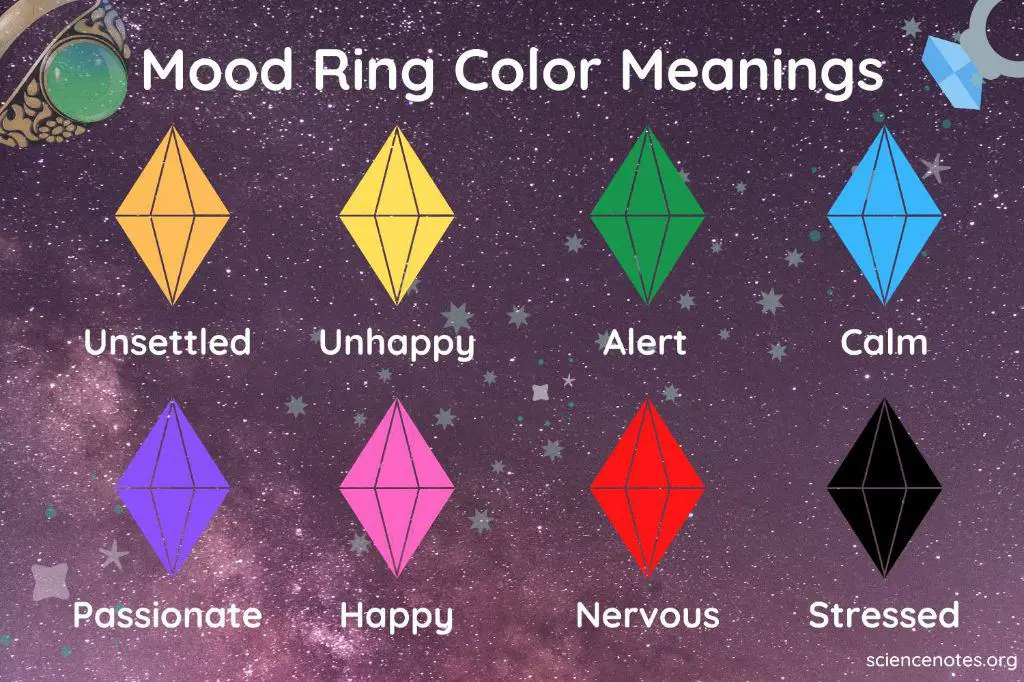Mood rings first became popular in the 1970s and were marketed as jewelry that could reveal a person’s mood or emotions through changing colors. The rings contain thermotropic liquid crystals that change color based on the temperature of the skin underneath. When worn on the finger, the mood ring responds to even minute changes in body temperature caused by shifts in emotions. But why does a mood ring turn purple specifically? And what does a purple color indicate about your mood? Keep reading to learn more about how mood rings work and what it means when your mood ring changes to a purple hue.
How Mood Rings Work
A mood ring contains special liquid crystals sealed underneath the stone or jewel on the ring. These thermotropic liquid crystals respond to small changes in temperature by reflecting different wavelengths of light. Essentially, the hotter your skin gets, the more the liquid crystals change shape and reflect different colors. Here’s a quick overview of how the technology works:
| Component | Function |
|---|---|
| Thermotropic liquid crystals | Change shape and reflect different light wavelengths based on temperature |
| Jewel/stone | Transparent covering that allows light reflection to be seen |
| Body heat from finger | Causes slight temperature changes that alter crystal structure |
The liquid crystals are calibrated to reflect certain colors at precise temperature ranges. Although not an exact science, the color changes give a general indication of your mood and stress levels. When you’re feeling relaxed and happy, your skin will be warmer and the mood ring will reflect warmer colors. When you’re stressed or upset, your skin temperature drops slightly, causing the crystals to reflect cooler colors.
Mood Ring Color Meanings
So what do the different mood ring colors mean? Here’s a quick guide to interpreting the colors you may see:
| Color | Meaning |
|---|---|
| Black | Stressed, tense, nervous |
| Blue | Relaxed, calm |
| Green | Normal, average mood |
| Yellow | Excited, happy, optimistic |
| Brown | Bored, dull, sluggish |
| Grey | Sad, anxious, upset |
| Purple | Passionate, loving, sensual |
As you can see, purple is associated with feeling passionate, loving, and sensual. So when your mood ring turns purple, it suggests you’re feeling amorous, intimate, and romantic.
Why Does My Mood Ring Turn Purple?
There are a few key reasons why your mood ring may shift to a passionate purple color:
- You’re feeling lovestruck and infatuated with someone
- You’re engaging in sensual, intimate activities
- You’re feeling attracted to or aroused by someone
- You’re experiencing tender, affectionate moments with a loved one
Essentially, a purple mood ring reflects being in an affectionate, amorous state. During intimate, loving encounters, your body temperature rises slightly due to increased blood flow, Flushing, and warm sensations. This warmth is picked up by the mood ring and displayed as a royal purple shade.
Some specific scenarios that may cause your mood ring to turn purple include:
- Having a romantic, candlelit dinner with your partner
- Slow dancing at your wedding with your new spouse
- Cuddling and gazing into your lover’s eyes
- Locking eyes with an attractive stranger across the room
- Kissing or being intimate with someone you have strong feelings for
- Experiencing sensual massage or foreplay
- Watching a steamy love scene in a movie and feeling turned on
In these situations, the flushed, excited feelings cause increased blood flow to the skin, making the mood ring turn a rosy purple shade.
Other Causes of Purple Mood Ring
While passion, arousal, and intimacy are the main reasons for a purple mood ring, here are a few other potential causes:
- Alcohol consumption – Drinking alcohol causes vasodilation (widening of blood vessels) which increases skin temperature. The mood ring interprets this as a change in emotions.
- Strenuous exercise – Vigorous physical activity heats up your body, which can alter the mood ring color.
- Hot environments – Exposure to heat sources like the sun, hot tubs, or saunas can warm your skin and skew the mood ring colors.
- Illness – Fevers associated with illnesses can also cause warmer skin and mood ring color changes.
So while passion and arousal are the primary drivers of a purple mood ring, be aware that other situational factors can produce similar color changes. Keep these other causes in mind when interpreting your mood ring signals.
Conclusion
In summary, your mood ring turns purple when you’re experiencing feelings of passion, intimacy, sensuality, attraction and love. A purple color reflects being in a warm, affectionate state due to increased blood flow and skin temperature changes. While this romantic mood is the main cause of purple, factors like drinking alcohol, exercise, hot environments and illness can produce similar color shifts. So pay attention to context clues when reading your mood ring colors. With practice, you’ll get better at interpreting the signals and predicting your purple-passionate moments!


